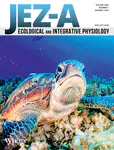Transition to Piscivory Seen Through Brain Transcriptomics in a Juvenile Percid Fish: Complex Interplay of Differential Gene Transcription, Alternative Splicing, and ncRNA Activity

Abstract
Pikeperch (Sander Lucioperca) belongs to main predatory fish species in freshwater bodies throughout Europe playing the key role by reducing planktivorous fish abundance. Two size classes of the young-of-the-year (YOY) pikeperch are known in Europe and North America. Our long-term fish survey elucidates late-summer size distribution of YOY pikeperch in the Lipno Reservoir (Czechia) and recognizes two distinct subcohorts: smaller pelagic planktivores heavily outnumber larger demersal piscivores. To explore molecular mechanisms accompanying the switch from planktivory to piscivory, we compared brain transcriptomes of both subcohorts and identified 148 differentially transcribed genes. The pathway enrichment analyses identified the piscivorous phase to be associated with genes involved in collagen and extracellular matrix generation with numerous Gene Ontology (GO), while the planktivorous phase was associated with genes for non-muscle-myosins (NMM) with less GO terms. Transcripts further upregulated in planktivores from the periphery of the NMM network were Pmchl, Pomcl, and Pyyb, all involved also in appetite control and producing (an)orexigenic neuropeptides. Noncoding RNAs were upregulated in transcriptomes of planktivores including three transcripts of snoRNA U85. Thirty genes mostly functionally unrelated to those differentially transcribed were alternatively spliced between the subcohorts. Our results indicate planktivores as potentially driven by voracity to initiate the switch to piscivory, while piscivores undergo a dynamic brain development. We propose a spatiotemporal spreading of juvenile development over a longer period and larger spatial scales through developmental plasticity as an adaptation to exploiting all types of resources and decreasing the intraspecific competition.